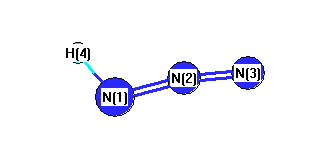Geometric Data

Point Group Cs
Internal coordinates
distances (r) in Å, angles (a) in degrees, dihedrals (d) in degrees
Cartesians
| Atom |
x (Å) |
y (Å) |
z (Å) |
| N1 |
-1.1636 |
-0.0605 |
0.0000 |
| N2 |
0.0730 |
-0.0184 |
0.0000 |
| N3 |
1.2052 |
0.0203 |
0.0000 |
| H4 |
-1.5922 |
0.8151 |
0.0000 |
Atom - Atom Distances 
Distances in Å
| |
N1 |
N2 |
N3 |
H4 |
| N1 |
|
1.2373 | 2.3702 | 0.9749 |
| N2 |
1.2373 |
|
1.1329 | 1.8622 |
| N3 |
2.3702 | 1.1329 |
|
2.9081 |
| H4 |
0.9749 | 1.8622 | 2.9081 |
|
Calculated geometries
for HN
3 (hydrogen azide).
Experimental Bond Angles (degrees) from cartesians 
| atom1 |
atom2 |
atom3 |
angle |
|
atom1 |
atom2 |
atom3 |
angle |
| N1 |
N2 |
N3 |
179.992 |
|
N2 |
N1 |
H4 |
114.132 |
Bond descriptions
Examples: C-C single bond, C=C, double bond, C#C triple bond, C:C aromatic bond
| Bond Type |
Count |
| N=N |
2 |
| H-N |
1 |
Connectivity
| Atom 1 |
Atom 2 |
| N1 |
N2 |
| N1 |
H4 |
| N2 |
N3 |











